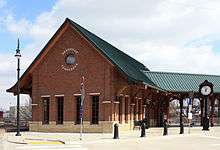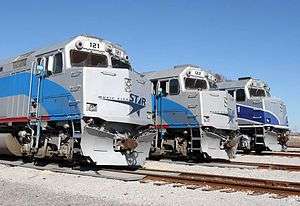Music City Star
 | |||||||||||||||||||||||||||||||||||||||||||||||||||||||||||||||||||||||||||||||||||||||||||||
|
Three EMD F40PH locomotives in use by the Music City Star lined up within the Lebanon, Tennessee yards. The third F40PH on the far right is painted in Amtrak Pacfic Surfliner scheme. | |||||||||||||||||||||||||||||||||||||||||||||||||||||||||||||||||||||||||||||||||||||||||||||
| Overview | |||||||||||||||||||||||||||||||||||||||||||||||||||||||||||||||||||||||||||||||||||||||||||||
|---|---|---|---|---|---|---|---|---|---|---|---|---|---|---|---|---|---|---|---|---|---|---|---|---|---|---|---|---|---|---|---|---|---|---|---|---|---|---|---|---|---|---|---|---|---|---|---|---|---|---|---|---|---|---|---|---|---|---|---|---|---|---|---|---|---|---|---|---|---|---|---|---|---|---|---|---|---|---|---|---|---|---|---|---|---|---|---|---|---|---|---|---|---|
| Owner | Tennessee Department of Transportation (TDOT) | ||||||||||||||||||||||||||||||||||||||||||||||||||||||||||||||||||||||||||||||||||||||||||||
| Locale | Nashville Metropolitan Area | ||||||||||||||||||||||||||||||||||||||||||||||||||||||||||||||||||||||||||||||||||||||||||||
| Transit type | Commuter rail | ||||||||||||||||||||||||||||||||||||||||||||||||||||||||||||||||||||||||||||||||||||||||||||
| Number of lines | 1 | ||||||||||||||||||||||||||||||||||||||||||||||||||||||||||||||||||||||||||||||||||||||||||||
| Number of stations | 6 | ||||||||||||||||||||||||||||||||||||||||||||||||||||||||||||||||||||||||||||||||||||||||||||
| Daily ridership | 1,225 (FY 2011)[1] | ||||||||||||||||||||||||||||||||||||||||||||||||||||||||||||||||||||||||||||||||||||||||||||
| Operation | |||||||||||||||||||||||||||||||||||||||||||||||||||||||||||||||||||||||||||||||||||||||||||||
| Began operation | September 18, 2006 | ||||||||||||||||||||||||||||||||||||||||||||||||||||||||||||||||||||||||||||||||||||||||||||
| Operator(s) | Tennessee Regional Transportation Authority (RTA) | ||||||||||||||||||||||||||||||||||||||||||||||||||||||||||||||||||||||||||||||||||||||||||||
| Reporting marks | NRTX | ||||||||||||||||||||||||||||||||||||||||||||||||||||||||||||||||||||||||||||||||||||||||||||
| Number of vehicles |
4 Locomotives 7 Coaches | ||||||||||||||||||||||||||||||||||||||||||||||||||||||||||||||||||||||||||||||||||||||||||||
| Train length | 3 Multi-level cars | ||||||||||||||||||||||||||||||||||||||||||||||||||||||||||||||||||||||||||||||||||||||||||||
| Technical | |||||||||||||||||||||||||||||||||||||||||||||||||||||||||||||||||||||||||||||||||||||||||||||
| System length | 32 miles (51.5 km) | ||||||||||||||||||||||||||||||||||||||||||||||||||||||||||||||||||||||||||||||||||||||||||||
| Track gauge | 4 ft 8 1⁄2 in (1,435 mm) (standard gauge) | ||||||||||||||||||||||||||||||||||||||||||||||||||||||||||||||||||||||||||||||||||||||||||||
| |||||||||||||||||||||||||||||||||||||||||||||||||||||||||||||||||||||||||||||||||||||||||||||
The Music City Star (reporting mark NRTX) is a commuter rail service running between Nashville and Lebanon, Tennessee. The service uses the existing track of the Nashville and Eastern Railroad. The line currently has six stops: Riverfront Station, Donelson, Hermitage, Mount Juliet, Martha (State Route 109 and U.S. Highway 70), and Lebanon. The operation covers 32 miles (51 kilometres) of rail line. Service began on September 18, 2006.[2]
Description
The Star is considered a "starter" project to demonstrate the effectiveness of commuter rail service to the metro Nashville area. Expansion plans include as many as six more lines, terminating in Gallatin, Columbia, Murfreesboro, Dickson, Springfield, and Clarksville via Ashland City. All are planned to use existing CSX Transportation railroad lines. The planned seven lines meet in central Nashville in a star formation, hence the name of the system, which also alludes to the city's many country music stars.
The Star is the first passenger train service of any kind for Nashville since the discontinuation of Amtrak's Floridian in 1979. The Nashville and Eastern line, part of the former Tennessee Central Railway, had not seen passenger service for many decades prior to the Star, with the exception of excursion trains operated by the Tennessee Central Railway Museum and the Broadway Dinner Train.
Rolling stock
| Model | Built | Number | Road Numbers |
|---|---|---|---|
| F40PH | 4 | 120-122, 381 | |
| Gallery cars | 7 | 400-402, 500-503 |
The Music City Star regional rail service is currently served by four rebuilt ex-Amtrak EMD F40PH locomotives and seven former Chicago Metra coaches, standard gauge. The coaches are bilevel rail cars with seating on both levels.[2]
 Typical multi-level passenger car as used by the Music City Star
Typical multi-level passenger car as used by the Music City Star The interior view inside a Music City Star passenger coach
The interior view inside a Music City Star passenger coach The operating cab car end of a Music City Star train at Riverfront Station
The operating cab car end of a Music City Star train at Riverfront Station
Lines

Currently there is only one line, with six more planned to other satellite cities around Nashville.
The current line is 32 miles long with 6 stations. The line is mostly one track, so this limits arrivals and departures to how long each train has to wait for the other to pass. The first "starter line" cost $41 million, or just under $1.3 million per mile, which made it the most cost efficient commuter rail start-up in the nation.[3]
East Corridor line
Ridership
Music City Star ridership steadily increased from 104,785 passenger trips in 2007 to 277,148 trips in 2012.[4] In 2013, ridership decreased to 253,421 trips.[4] The service's highest ridership on a single day occurred on April 19, 2011, when 1,374 passengers were carried.[1]
History
The train began operations on September 18, 2006, becoming the 18th commuter rail system in the United States,[2] with a projected daily ridership of 1,500 passengers. The service launched with an estimated annual cost of $3.3 million, of which $1.3 million was covered by revenues.[5]
In the first month after service began, ridership failed to reach the projected goals,[5] a situation which continued for several years, culminating with a financial shortfall of $1.7 million by the summer of 2008, of which the state of Tennessee covered $1 million in a bailout of the service.[6] Financial difficulties continued into the next year; in June 2009, the service was nearly shut down for lack of funds until state and local authorities granted the service $4.4 million to continue service until 2011.[7]
During 2010, a third passenger car was added to all Music City Star trains to accommodate increasing ridership.[8]
On May 2, 2010, the East Corridor line was closed because of damage related to the floods that hit Middle Tennessee. Flood waters pushed tracks off a concrete trestle over Sinking Creek in downtown Lebanon. This trapped Star trains at their Lebanon storage yard, causing RTA to suspend service until the trestle was repaired. MTA substituted chartered buses instead, picking up passengers at all stations except Martha.[9] The line was repaired in one week.
Fiscal year 2011 saw a 24 percent increase in total trips from the previous year, with a daily average ride increase of 45 percent at 1,225 per day.[1]
See also
References
- 1 2 3 "Music City Star experiences record year of ridership" (PDF). Regional Transportation Authority. September 13, 2011. Retrieved January 12, 2012.
- 1 2 3 "A Star is born: Nashville commuter trains to begin Sept. 18". Trains. August 21, 2015. Retrieved August 6, 2010.
- ↑ Latham, Garl B. (2008). Rail Transit: An Oklahoma Economic Opportunity (PDF). OnTrac. Archived from the original (PDF) on June 28, 2010.
- 1 2 Harrison, Scott (May 2, 2014). "The little engine that hasn't: Thinking it can hasn't been enough for Music City Star". Nashville Business Journal. Retrieved August 21, 2015.
- 1 2 "Music City Star fails to meet ridership goals". Trains. October 27, 2006.
- ↑ "Tennessee offers to bail out Music City Star". Trains. July 17, 2008.
- ↑ "Music City Star gets two more years of funding". Trains. June 22, 2009.
- ↑ "Music City Star ridership continues to climb" (PDF). Regional Transportation Authority. October 12, 2010. Retrieved October 19, 2010.
- ↑ "Bus, Train Service Suspended". NewsChannel5.com. May 2, 2010. Archived from the original on May 6, 2010.
External links
| Wikimedia Commons has media related to Music City Star. |
